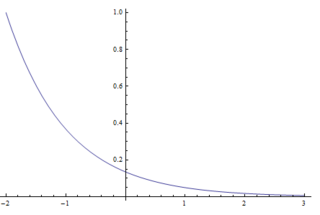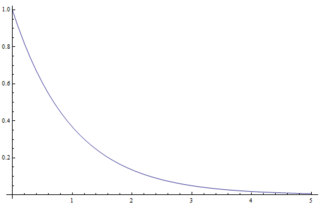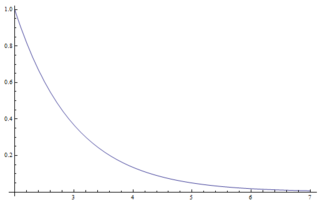Convolution
Convolution is often presented in a manner that emphasizes efficient calculation over comprehension of the convolution itself. To calculate in a pointwise fashion, we're told: "flip one of the input signals, and perform shift+multiply+add operations until the signals no longer overlap." This is numerically valid, but you could in fact calculate the convolution without flipping either signals. We'll perform the latter here for illustration. Consider the convolution of the following constant input and causal impulse reponse:
$ y[n] \,=\, x[n] \ast h[n] $
$ x[n] \,=\, 1 \;\;\;\;\; \forall \, n $
$ h[n] = \left\{ \begin{array}{lr} \mathrm{e}^{-n} & : n \geq 0\\ 0 & : n < 0 \end{array} \right. $
Our input function x is a constant 1. You can think of this as a (Kronecker) delta function occurring at every discrete time step, and therefore causing the impulse reponse to 'go off' at every time step (see graphs below for better visualization). What we term the 'convolution' is just the summation of all these time-shifted impulse reponses that have non-zero outputs at the time we want to find the convolution for (ie time n for y[n]). To be more specific we can consider an impulse that was generated at time n=0. We know that output from that singular impulse response should be $ (1)(e^{0}) = 1 $ at n=0, $ (1)(e^{-1}) = e^{-1} $ at n=1, $ (1)(e^{-2}) = e^{-2} $ at n=2, and so on. Another impulse would be generated at n=1, yielding $ (1)(0) = 0 $ at n=0, $ (1)(e^{0}) = 1 $ at n=1, $ (1)(e^{-1}) = e^{-1} $ at n=2, and so on. Look at what's occurring at n=1 here: the convolution will yield $ 1 + e^{-1} $ for the two impulse responses mentioned here. But if we carry this back to earlier impulse responses, we see that we get the geometric series:
$ \sum_{k=0}^{\infty} \mathrm{e}^{-k} \,=\, 1 + \frac{1}{e} + \frac{1}{e^2} + \frac{1}{e^3} + ... \,=\, \frac{1}{1-\frac{1}{e}} \,\approx\, 1.582 $
Without even resorting to the convolution formula given to us in class, we intuitively grasped what the convolution should be for any time n (doesn't matter what n we choose since input has always been and will always be the same), and calculated the output y[n] for all n. Again to clarify, the impulse response calculated here was just the (additive) superposition of time-shifted impulse functions. And because our input is 1 for all n, each of those superimposed impulse responses is scaled with constant coefficient of 1, simplifying our computation to a geometric series.
Now that we've figured out the discrete time case, let's consider the continuous case of these same input and impulse response functions, now defined for all t instead of at discrete intervals n. Using the same intuition as before, in which we consider additive superposition of identically scaled but time-shifted impulse response, we see that instead of having a countably infinite number of values to add (eg $ 1, e^{-1}, e^{-2}, ... $), we now have an uncountably infinite number of values to add (starting with 1, $ 1^-, ... $).
$ \int_{-\infty}^{\infty} h(\tau)\,\mathrm{d}\tau \,=\, \int_{0}^{\infty} h(\tau)\,\mathrm{d}\tau \;\;\;\;\; \because h(t)=0 \;\;\; \forall \, t<0 $
$ \Rightarrow \int_{0}^{\infty} \mathrm{e}^{-\tau}\,\mathrm{d}\tau \,=\, \left.-\mathrm{e}^{-\tau}\right|_{0}^{\infty} \,=\, -(\mathrm{e}^{-\infty} - \mathrm{e}^{0}) \,=\, -(0 - 1) \,=\, 1 $
$ \int_{-\infty}^{\infty} h(t-\tau)\,\mathrm{d}\tau \,=\, \int_{-\infty}^{t} h(t-\tau)\,\mathrm{d}\tau \;\;\;\;\; \because h(t)=0 \;\;\; \forall \, t<0 $
$ \Rightarrow \int_{-\infty}^{t} \mathrm{e}^{-(t-\tau)}\,\mathrm{d}\tau \,=\, \int_{-\infty}^{t} \mathrm{e}^{\tau-t}\,\mathrm{d}\tau \,=\, \left.\mathrm{e}^{\tau-t}\right|_{-\infty}^{t} \,=\, \mathrm{e}^{0} - \mathrm{e}^{-\infty-t} \;\; (\forall \, t>0) \,=\, 1 - 0 \,=\, 1 $




